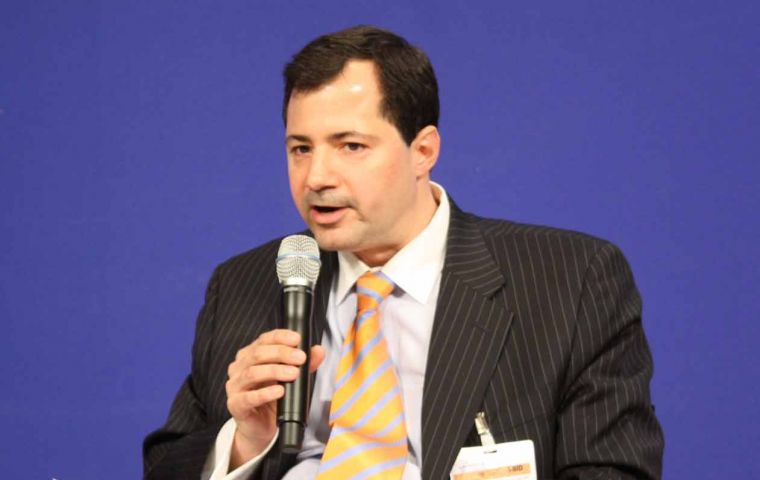MercoPress. South Atlantic News Agency
IDB plans to double financing to private companies to boost job creation
 Steven Puig, Vice-President for the IDB’s private sector and non-sovereign guaranteed operations
Steven Puig, Vice-President for the IDB’s private sector and non-sovereign guaranteed operations The Inter-American Development Bank Group expects to more than double its annual financing to companies in Latin America and the Caribbean over the next four years, a move that will help the Group fulfill its mission to promote development though the private sector in the region.
Private sector financing by the IDB Group -- including loans and grants -- is expected to exceed 3.0 billion US dollars per year by 2015 from 1.4 billion in 2010. The Group is comprised by the Inter-American Development Bank (IDB), the Inter-American Investment Corporation (IIC) and the Multilateral Investment Fund (MIF).
The IDB is expected to increase its operations without a sovereign guarantee in small and vulnerable countries in the region and boost lending to private sector projects that will help promote greater social inclusion and poverty reduction, as well as help the region mitigate and adapt to the effects of climate change and improve its competitiveness with better infrastructure.
That means, for example, that the IDB will increase its support for traditional infrastructure projects, such as roads and airports, as well as projects in areas such as health care, education, renewable energy and energy efficiency.
“One of the biggest challenges for Latin America and the Caribbean in the next decade is to achieve a sustainable level of economic growth. Since the private sector creates on average nearly 90% of all the jobs in the region, increasing support for this sector can be a very effective tool to speed up the region’s lagging growth, create more jobs, and improve the lives of the poor,’’ said Steven Puig, Vice-President for the IDB’s private sector and non-sovereign guaranteed operations.
“We are looking to finance projects that can help improve the lives of people, integrate the poor into the formal economy and promote a type of development that is environmentally and economically sustainable.”
The increase in financing to the private sector in coming years will contribute for the IDB to fulfill the mandates set by the Bank’s Governors for its capital increase. Last year, the Board of Governors of the IDB agreed to a $70 billion increase of the Bank’s ordinary capital, the largest expansion of resources in the IDB’s history.
Under the terms of the accord, the Bank's Governors approved an increase in financing without sovereign guarantees. Given the current characteristics of the portfolio without sovereign guarantee, this means that the IDB could grow more than twice the volume of loans and guarantees to the private sector. In addition, the Governors of the IDB delegated the approval of future changes to this limit to the Executive Board of the Bank.
Under the capital increase, the IDB is expected to boost total lending to small and vulnerable countries to 35% of its total lending by the end of 2015. Lending in support of climate change adaptation initiatives as well as projects in renewable energy and environmental sustainability is expected to reach 25% of total lending by 2015, from an average of 5% over the 2006 to 2009 period.
Lending for poverty reduction and equity enhancement programs is expected to increase to as much as 50% of the Bank’s total lending by the end of 2015.




Top Comments
Disclaimer & comment rules-

Read all commentsWhat would be really useful would be for the USA IDB Group to promote, and initially fund, road infrastructure building techniques that match, and better in quality, those of the Romans 2000 years ago.
Mar 28th, 2011 - 06:12 pm 0Not a criticism, as roads were built for wheels, and South America never invented the wheel, and had to wait until very recently, in historic terms, for wheels to arrive from overseas. Therefore the roads of S.A. are a very recent thing, and many municipalities even now simply lay tarmac on sand, relying on cheap labour to be constantly employed in filling holes, patching roads and shoreing-up landslipped road margins.
But a single 44 tonne axle-weight truck can easily break up such a road along its full length in a single journey.
So when the Chinese say they want to build a 'dry canal' from the eastern seaboard to the pacific coast to facilitate bulk flow of (raw) materials to China, the quality of the road to be built will be at least as good as the roads of Telford in British Victorian times.
The USA knows how to build virgin roads across continents - they have been doing it across America since 1880. The technology transfer to (eg) Brasil would be worth its weight in errr apples/soya/cotton.
A road network across Brasil - even to equal that of the Romans across Europe 2000 years earlier - would be such a leap forward into the 21st century for South America.
CESMM3 protocols tell it like it is.
If a generation of civil engineering graduates AND federal and state governors and administrative managers learned and applied these protocols in national road construction, the paradigm shift could move so many areas of national infrastructure 'into the developed world'.
Commenting for this story is now closed.
If you have a Facebook account, become a fan and comment on our Facebook Page!